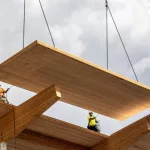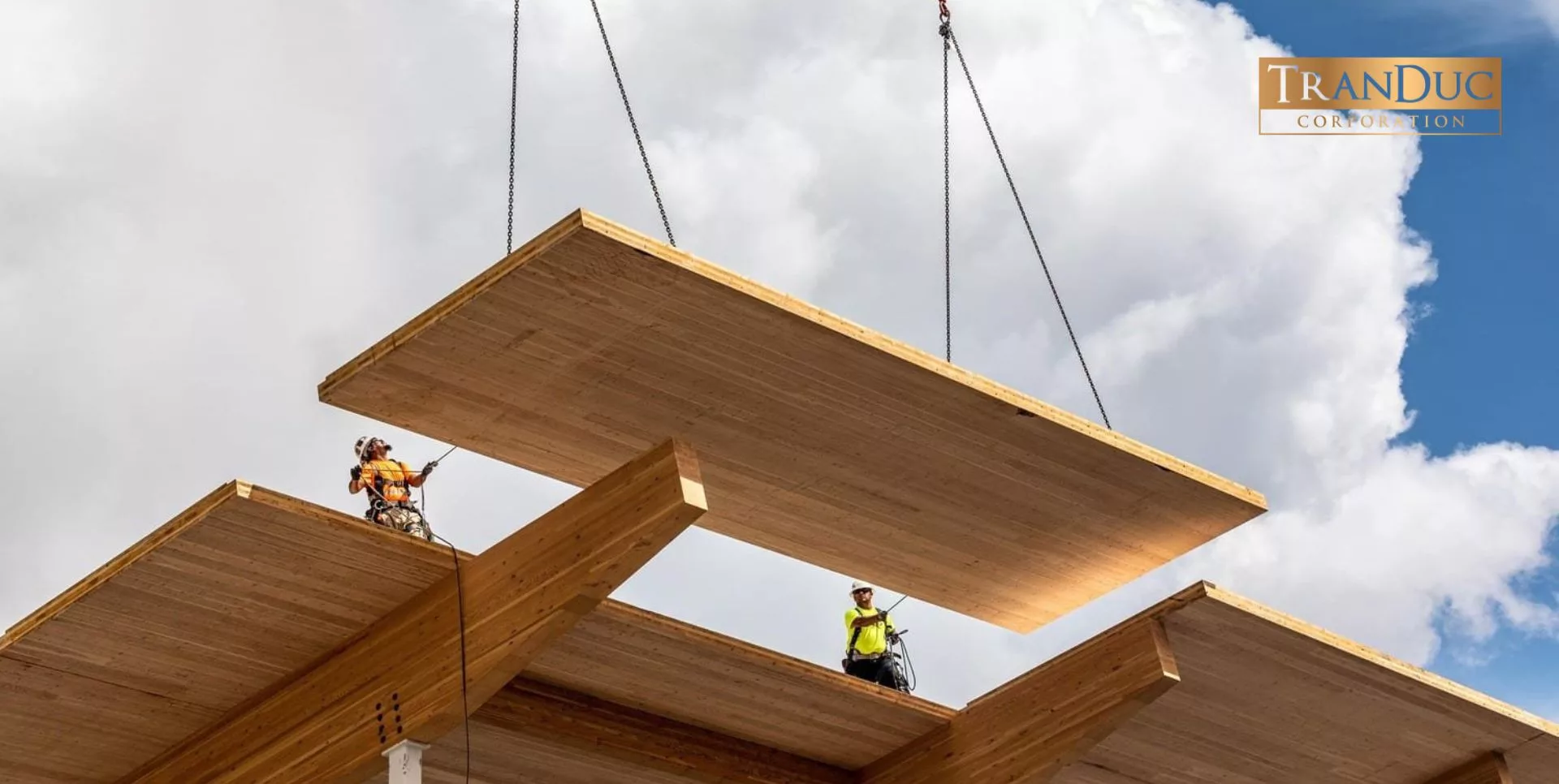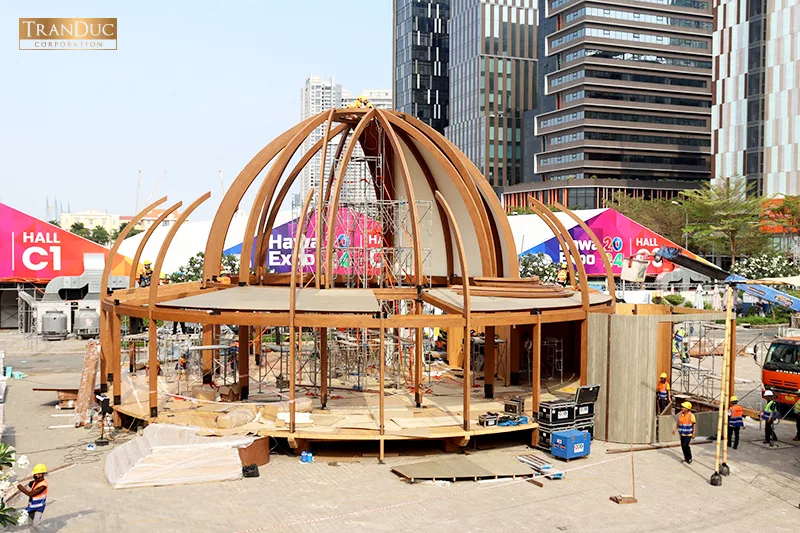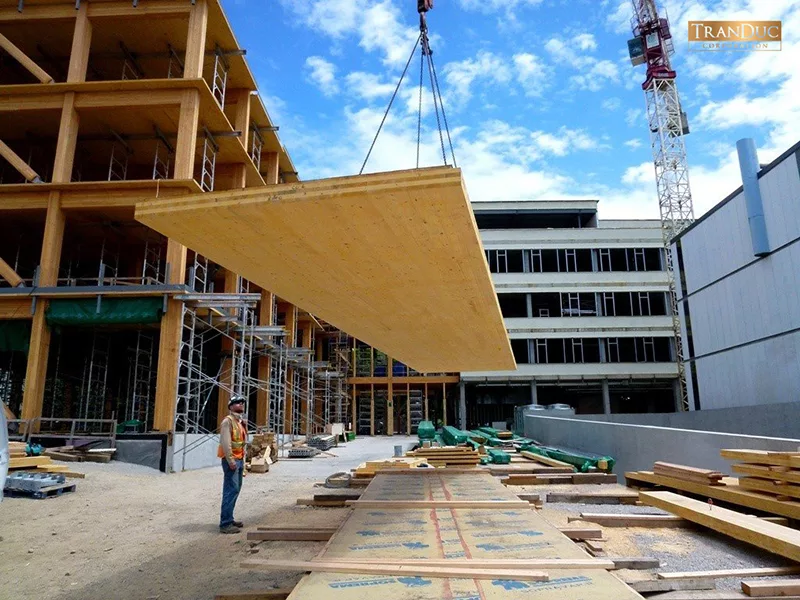
CLT Widely Applied Worldwide
What is CLT – Cross Laminated Timber?
CLT is a building material formed by stacking and joining multiple layers of wood at right angles, then bonding them together with specialized adhesives. This multi-layered cross-lamination process creates a robust structure, enhancing the material’s strength and durability.

CLT được ghép từ nhiều lớp vuông góc với nhau tạo nên cấu trúc bền chắc
7 Outstanding Advantages of CLT Components
- Design Flexibility: CLT unlocks creative spaces for architects with its flexible design capabilities and natural interaction with the environment. CLT can be used in roofs, walls, ceilings, and floors. In the hands of architects, CLT is not just a building material but a tool to create unique and impressive architectural designs.
The combination of CLT in high-rise buildings or green construction projects creates a revolution in the architecture and construction industry. Dubbed “green concrete” made from wood, CLT components are not just a material but a significant milestone and innovation in this field.
- Sustainability: Wood is a renewable resource, and responsible forest management and harvesting ensure a continuous wood supply. Combined with the energy-efficient production process of CLT components, this not only optimizes CO₂ emissions but also minimizes the greenhouse effect.
Using wood as a building material marks a significant step in addressing the shortage of traditional building materials. CLT components not only meet current needs but also provide a sustainable construction solution that can completely replace concrete in the future.
Furthermore, the sustainability of CLT lies in the lifecycle of its raw material:
- Raw Materials: The process begins with collecting wood from sustainably managed forests. The wood is carefully selected and processed into cross-laminated timber panels.
- Factory Production: At the factory, the wood is cut, cross-laminated, and bonded to form CLT components. This production process is energy-efficient and reduces CO₂ emissions compared to concrete production.
- Construction Site Transportation: CLT panels are transported to the construction site, where they are assembled into structural components such as walls, floors, partitions, and ceilings. Using CLT in construction saves time, reduces waste, and creates sustainable buildings.
- Recycling or Reuse: When a building is no longer in use, CLT can be recycled or reused in other projects. This minimizes environmental impact and optimizes wood resource utilization.
- Load-Bearing Capacity: Despite its seemingly simple appearance, the structure of CLT is remarkably complex. With impressive load-bearing capacity in both directions, CLT components are designed flexibly in various sizes and strengths to suit different construction projects, including high-rise buildings.
- Construction Speed: CLT is manufactured at the factory and transported to the construction site for assembly, significantly reducing construction time and costs compared to traditional methods.
- Fire Resistance: Fire resistance is always a top priority in any construction project, and CLT does not compromise on this aspect. When exposed to fire, the surface layer of CLT components quickly chars and forms a protective layer, slowing down the spread of flames.
This fire resistance feature is not only a crucial safety advantage but also provides peace of mind for contractors and investors. Additionally, fire-resistant coatings can be applied to CLT panels to further enhance safety, ensuring that the building meets the highest safety standards.
- Thermal Insulation and Energy Efficiency: Thermal insulation and energy efficiency are essential for building materials, especially in high-rise buildings.
CLT components are known for their excellent thermal insulation, reducing energy demand in both summer and winter. By providing an effective barrier, CLT helps maintain a moderate indoor temperature, optimizing energy use and creating a comfortable environment for occupants.
- Sound Insulation: Sound insulation is crucial for high-rise buildings, particularly in mixed-use complexes where the proximity of living, working, and commercial spaces can generate noise.
With advanced technology, CLT components offer effective sound insulation, creating a quiet and comfortable indoor environment, especially in high-rise buildings used for residential and commercial purposes

With its outstanding advantages, CLT can completely replace concrete in construction.
Worldwide Applications of CLT Components
CLT components have become indispensable in many construction projects worldwide. Here are some notable projects that have used CLT:
- Brock Commons Tallwood House, Canada: Brock Commons is an 18-story high-rise building at the University of British Columbia in Vancouver, Canada. Built with CLT, this building is a testament to the progress of CLT in high-rise construction.
- Tallwood House Hotel, Australia: Located at Monash University in Melbourne, Tallwood House is a hotel built entirely with CLT. Its airy and sustainable design demonstrates the versatility of CLT.
- Forté Tower, Australia: Forté Tower in Docklands is one of the first high-rise buildings built entirely from CLT. With 10 stories and a height of 32 meters, it is a symbol of CLT’s innovation and efficiency in construction.
- Forestay Water Tower, Japan: The Forestay Water Tower in Kodaira, Japan, is another example of CLT application. Its open and modern architecture showcases CLT’s flexibility in infrastructure projects.
- Murray Grove Building, UK: Murray Grove is a 9-story apartment building in London, UK, built with CLT. It is one of the exemplary projects using CLT in urban housing construction in Europe.
- T3 Minneapolis Building, USA: T3 Minneapolis is a 7-story office building in Minneapolis, Minnesota, USA, built entirely with CLT. It is one of the first US projects to use CLT for commercial purposes.
- Dock Road Redevelopment, South Africa: The Dock Road Redevelopment in Cape Town, South Africa, is a residential housing project using CLT. It is one of the first projects in Africa to use CLT to improve community living conditions.
Portland International Airport: Portland International Airport is an excellent example of using CLT components in large infrastructure projects. The use of CLT in The Canopy project at Portland International Airport not only brings technical and design benefits but also contributes to the airport’s and surrounding community’s sustainability and development goals.
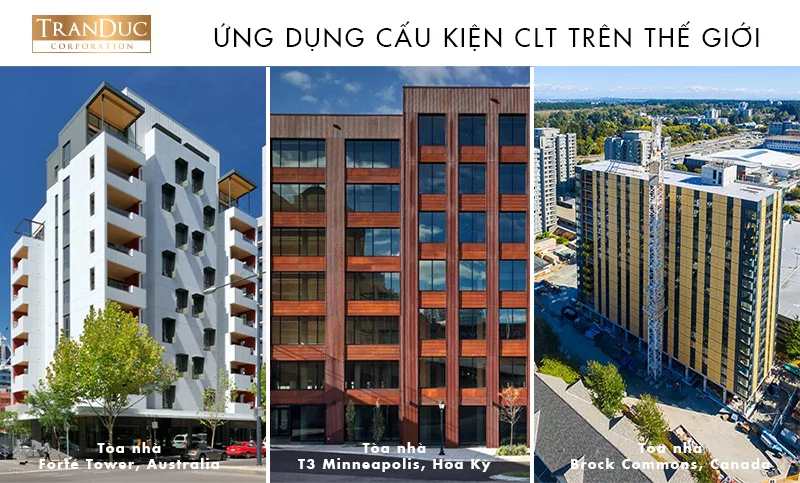
Some projects using CLT worldwide.
The Importance of CLT in Vietnam’s Construction Industry
In the context of global climate change, the architecture and construction industry is striving to find sustainable solutions to minimize environmental impact. CLT, also known as “green concrete,” is gradually asserting its important role in the future.
In Vietnam, TranDuc Homes has pioneered the use of CLT by importing a production line in late 2023, promising to be a significant turning point, opening a new direction for the construction industry in Vietnam. With a commitment to sustainable development, TranDuc Homes is the first to own a CLT production line in Southeast Asia.
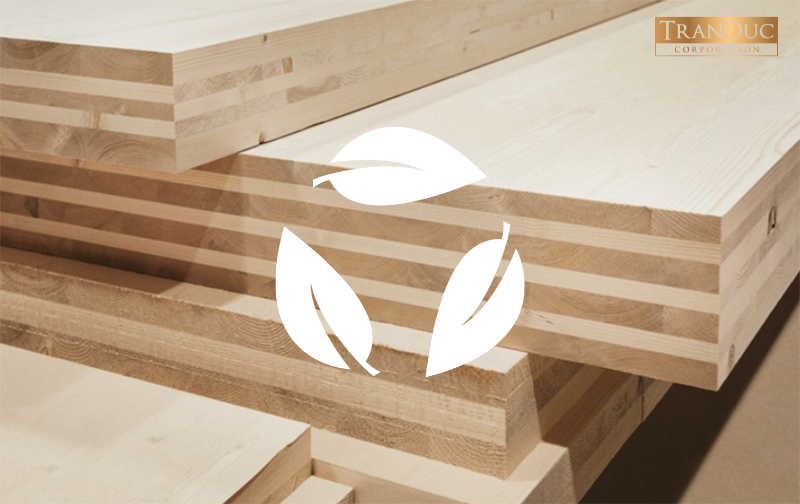
CLT is a complete replacement for concrete, helping to minimize environmental impact
Challenges, Opportunities, and Solutions
The development of CLT components presents both opportunities and challenges in implementation and use. Here are some notable points about the challenges, opportunities, and solutions that CLT components bring:
Challenges
- Awareness and Knowledge: Although CLT has proven to be a sustainable construction solution, awareness and knowledge about its advantages remain low, especially in the traditional construction sector.
Opportunities
- Sustainability and Energy Efficiency: CLT offers significant opportunities to enhance sustainability and energy efficiency in the construction industry, meeting the growing demand for green and environmentally friendly buildings.
- Improved Construction Efficiency: The rapid assembly capability of CLT enhances construction efficiency and reduces project completion time, bringing significant economic benefits.
Solutions
- Enhanced Education and Promotion: To overcome the challenges of awareness and knowledge, it is necessary to enhance education and promotion of the advantages and potential of CLT.
- Government Policy Development and Support: The government can play a crucial role in developing policies and providing financial support for CLT projects, thereby promoting the development of the CLT industry.
- Technical Research and Development: Continued research and development of CLT production technology will help improve quality and reduce production costs, increasing the competitiveness of this material in the market.
TranDuc Homes uses CLT and sustainable materials in the HAWA 2024 fair booth
With the current global climate change, CLT components – a green construction solution that completely replaces concrete – have emerged with an undeniable role in meeting the need to minimize negative environmental impacts.
CLT is not only an advanced technical solution but also part of a comprehensive solution to the current climate crisis. The shift from using concrete to CLT promises a significant step in building sustainable projects in Vietnam and promotes innovation and creativity in the design and construction sector.
To quickly view the latest information from TranDuc Homes, please visit here.
Contact us for more information
[email protected]
0988 897 997
